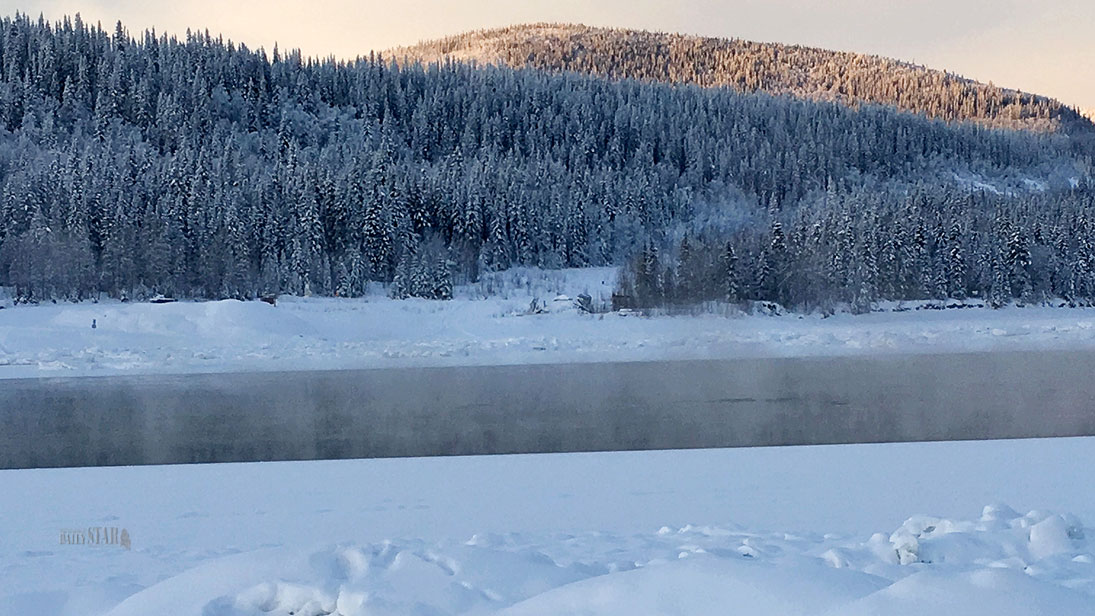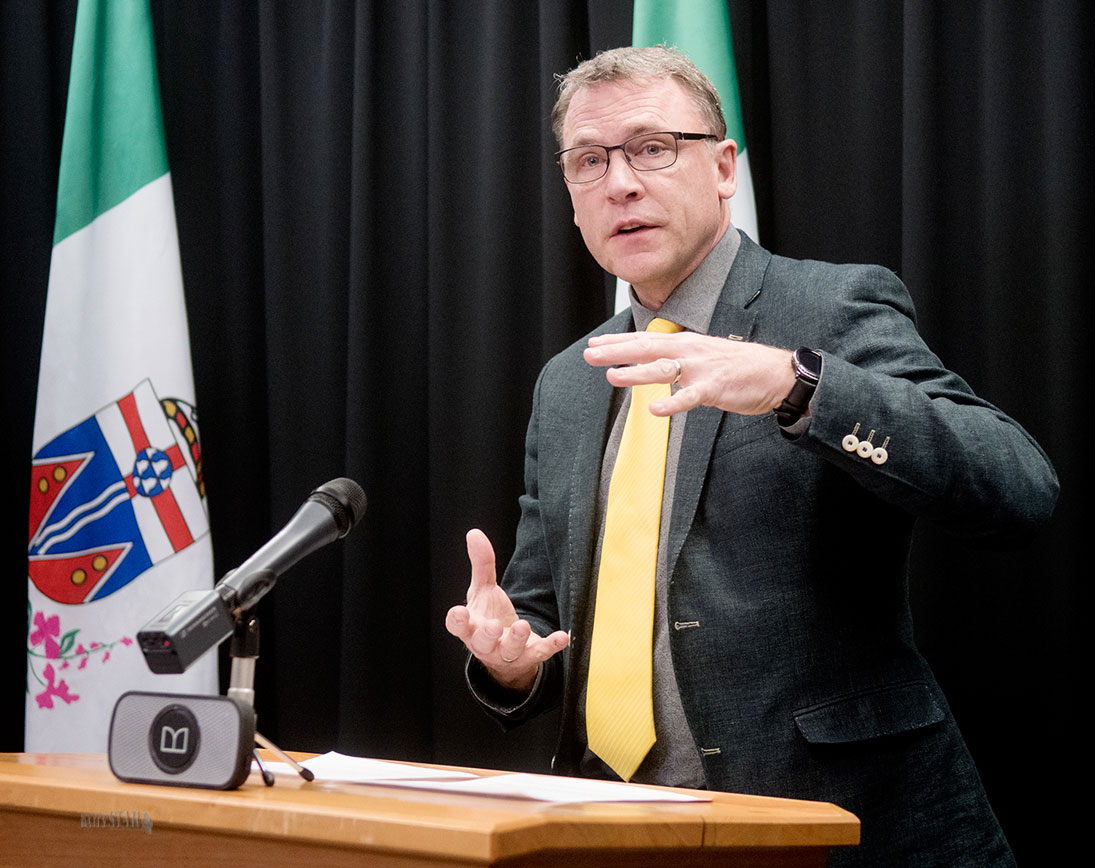
Photo by Dan Davidson
THE PROBLEM – The wide-open Yukon River is seen at Dawson’s ferry landing this week.

Photo by Dan Davidson
THE PROBLEM – The wide-open Yukon River is seen at Dawson’s ferry landing this week.

Photo by Vince Fedoroff
THE COLD REALITY – Highways and Public Works Minister Richard Mostyn, seen at Thursday’s news conference, says officials are ‘fairly confident’ the ice bridge plan will succeed.
“fickle” Mother Nature has forced the Yukon government to take unprecedented action in Dawson City, Highways and Public Works Minister Richard Mostyn said Thursday.
DAWSON CITY – A “fickle” Mother Nature has forced the Yukon government to take unprecedented action in Dawson City, Highways and Public Works Minister Richard Mostyn said Thursday.
In Whitehorse, Mostyn held a press conference on the need for a stable, reliable winter river crossing between Dawson and West Dawson.
“This morning, I’m here to announce that the Government of Yukon is going to try to freeze the Yukon River up in Dawson City from Dawson to West Dawson,” the minister said.
“This has never been tried before in the territory. It’s a situation that I’d prefer not to have to do, but we’ve got conditions in the Klondike these days that are abnormal.
“Last year, the river didn’t freeze. This year, it’s not looking like it’s going to freeze again. So we’re going to take some action.”
The Yukon River in front of Dawson, from the mouth of the Klondike to well past Moosehide, remains open this year, as it did last year, nearly two months after the George Black ferry ceased operations.
West Dawsonites and Sunnydale residents are crossing the river, where it’s frozen well south of town, but it’s a crossing that involves 10 to 15 kilometres of travel on foot, by dog team, on skis or by snowmobile.
After the river did not freeze, and there was no regular sanctioned crossing last year, Mostyn committed to the residents of West Dawson that the government would try to do something if it happened again this year.
“In March, we got our engineers to assess the conditions on the river in last season and then to come up with some sort of solutions for this year,” the minister said.
“What we’ve come up with is a plan to assist Mother Nature, who is a fickle mistress, and we’re going to help her create an ice bridge across the Yukon River.”
Mostyn noted that last year was the first year that his department was unable to maintain a link between the two parts of the Klondike.
As a rule, in normal circumstances, the first crossing of the river has been created by residents within a month of the river freezing, which is usually not too long after the ferry is pulled.
Walking trails give way to snowmobile and ATV trails and, as the ice thickens, smaller four-wheel-drive vehicles.
In recent years, a groomer has been used to smooth the trail for larger and less robust vehicles.
After a few weeks of this, the ice is thick enough to allow the highway crew’s heavier equipment to smooth out the trail, widen it, and flood it to even greater thickness.
They can then create an ice highway across the river, usually at the ferry landing, though it has been done successfully both upstream and downstream from that point.
Last year, this proved impossible. Two trails were created south of the confluence. One collapsed mid-winter; the other lasted for a shortened crossing season.
Last year, the ice pretty much vanished from the river within days of the ferry’s withdrawal. This year, there seemed to be healthy ice floes building up for about 14 days, but they never did jam enough to block the channel at the important spot, and eventually, they all flowed away.
This week, looking at the river beneath the ice fog, a person will see occasional small panes of ice that look no thicker that window glass.
The river has jammed and frozen to the south, but there’s wide open water flowing as much as six kilometres past the town.
At the press conference, the minister said the process should begin in January and take about three weeks to complete, according to the experts the department has consulted.
Normally, creating and maintaining an ice bridge costs $80,000 for a season. This method will cost $100,000 just for construction and maintenance, plus an additional $100,000 for what he referred to as “one-time” engineering costs.
Under the best conditions, the technique of spraying ice water over the river to encourage it to freeze would be accomplished with some specialized equipment that has proven its worth in other places.
Mostyn’s team was not sure if that equipment would be available, but he said he has been told there are other, old-fashioned, less efficient ways to accomplish the same end.
“We have quite a few experienced people (from Tetra Tech) working ion this project. We also have the in-house experience of Pubic Works, who have done this forever.
“Combined, we’re fairly confident we’re going to be able to carry this out.
“There are no guarantees,” he said. “Things are changing up here.
“The climate is not what it once was, and so we’re going to have to be innovative in dealing with some of the impacts that this changing climate is having on our lives. And this is one of the projects we’re going to start with.”
Searching for a better analogy to describe the process, Mostyn responded to questions by calling it “an ice Band-Aid across the channel.”
The minister ruled out any thoughts, for the moment, of considering an actual permanent bridge across the river, referring to a plan that was last considered around the turn of this century, according to local resident Dick Van Nostrand. He was involved with the local chamber of commerce’s bridge committee at that time.
During the press conference, Mostyn thought the last serious discussion of a bridge was in 1992, but this is not correct.
In fact, a bridge was part of the Yukon Party’s election platform in 2002 and was only cancelled due to rising cost of materials, as was reported in the Star on July 29, 2005.
The ferry landing remains the preferred location for any kind of bridge.
It’s one of the shortest distances across the river and, as Mostyn noted, is the place where all previous engineering has been done and all the permits are in place.
In a press release later Thursday afternoon, Mostyn was quoted as saying, “It is important residents of West Dawson can access Dawson. As our climate changes, we are going to have to find innovative solutions to deal with the problems we face. This year, manufactured ice formation is a tool we will experiment with to help the residents of West Dawson.”
Dawson Mayor Wayne Potoroka said he was glad to have heard the press conference. He was one of a number of people watching the Facebook stream and commenting on it.
Most reaction was positive, though there was a level of Dawson quirkiness.
“We’re going to see more and more of this as the years go by,” Potoroka said.
“I think climate change is very much upon us. We’ve go to plan for it. This is what adaptation looks like. It’s almost surreal that we would have to be doing this, but this is … the new normal.
“I think it’s worth a shot. I’m glad that they’re actually taking this extra measure to produce a bridge.”
In order to encourage thoughtful and responsible discussion, website comments will not be visible until a moderator approves them. Please add comments judiciously and refrain from maligning any individual or institution. Read about our user comment and privacy policies.
Your name and email address are required before your comment is posted. Otherwise, your comment will not be posted.
Comments (10)
Up 0 Down 0
say what on Jan 1, 2018 at 4:14 pm
Thought that the 3 million spent by feds on skating rink was dumb, I guess Yukon liberals have just beat that with $200,000 worth of water sprayed into the Yukon river. Other concern is that this may well be the start of a yearly waste of money.
Up 2 Down 0
Not really on Dec 28, 2017 at 2:09 pm
Dear Really?
Yukon Party had a design and bid in place in 2005 and said no to the bridge based on the price (that would now look super cheap) being too expensive. The idea YP said no in fear of the opposing views of maybe 30 residents at the time (that would never have voted for them anyway) is absurd.
Highways needs a crossing to get equipment across to clear the Top of the World before it disintegrates under the spring melt. Miners need early access to properties in Sixty Mile and Forty Mile. The needs are much broader than just the residents.
Up 1 Down 1
Really? on Dec 28, 2017 at 11:46 am
Really?
Does anybody realize that the Yukon Party had a deal with Alaska to build the bridge in Dawson, of which Alaska was going to pay a significant cost of? Also Alaska was going to allow Canadian contractors to bid on highway maintenance contracts. The bridge would have allowed electricity/sewage/water over the river as well.
But the people of WEST Dawson rallied against it, said it was going to change things for them, screwing over everybody else that it would have benefited (tourism, business, utilities to west Dawson)
And now they are crying, let them reap what they sowed, this is ridiculous in every sense! Tired of a handful of people wanting it one way, then whining when it doesn't benefit them.
Up 2 Down 0
ProScience Greenie on Dec 28, 2017 at 11:33 am
Worth a shot but put more money into pumping and spraying and less into the engineering. Too often, too much money is wasted by over-engineering tasks that are not rocket science. I'm not anti-engineering, just tired of this never ending feeding from the taxpayer's gravy train by our usual horde of corporate welfare addicted consultants.
Up 1 Down 0
Karl on Dec 27, 2017 at 6:12 pm
It would be cheaper to put all the west Dawson residents up in hotels for the winter.
Up 1 Down 0
Groucho d'North on Dec 27, 2017 at 10:55 am
I foresee a cluster of ducks soon to be seen on this patch of water.
Up 1 Down 0
Alan Boomer on Dec 26, 2017 at 2:50 pm
If west Dawson residents live off grid they should provide the solution themselves.
Why not a communal hovercraft for passenger traffic that runs a few times a day and also just after closing time at the Pit.
Up 2 Down 0
My Opinion on Dec 25, 2017 at 3:55 pm
Prior to the fourth wheel (Turbine) being installed at the Whitehorse dam, the river would freeze solid in front of Whitehorse but in 1976 we had an incredible warm winter and the river never froze. Instead of the Dog Races and Snowmobile races on the river in front of the White Pass Station at Rendezvous we had canoe races. Don't panic just yet, it is getting pretty cool and could get very cold and everything will change. Besides those people decided to live off the grid, they can buy a snowmobile and continue to live the lifestyle they apparently wanted.
Up 2 Down 0
BnR on Dec 24, 2017 at 12:05 pm
I thought this was an early April Fools story.
I think it would be cheaper in the long run to buy everyone on the other side a boat.
Up 3 Down 0
Hmmm on Dec 24, 2017 at 9:45 am
So we pay $200,000 so that people who purposely chose to live on the other side of the river with no bridge can drive a car across the river?